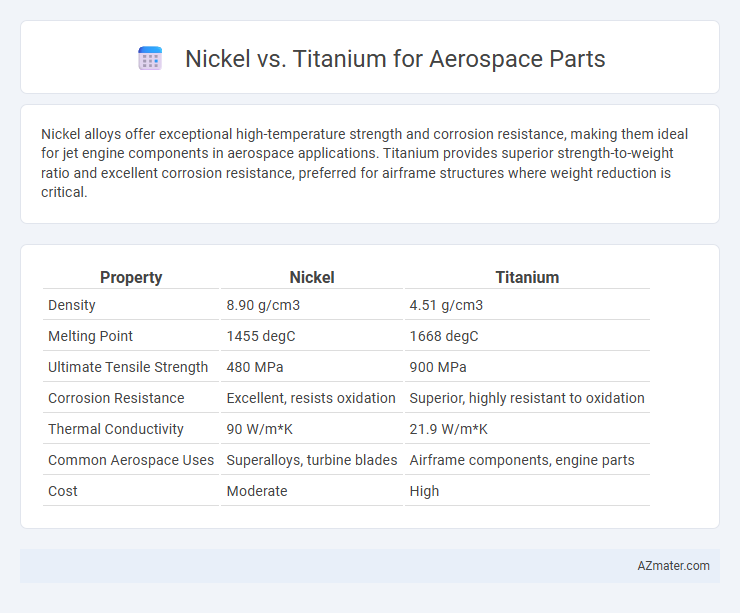Nickel alloys offer exceptional high-temperature strength and corrosion resistance, making them ideal for jet engine components in aerospace applications. Titanium provides superior strength-to-weight ratio and excellent corrosion resistance, preferred for airframe structures where weight reduction is critical.
Table of Comparison
| Property | Nickel | Titanium |
|---|---|---|
| Density | 8.90 g/cm3 | 4.51 g/cm3 |
| Melting Point | 1455 degC | 1668 degC |
| Ultimate Tensile Strength | 480 MPa | 900 MPa |
| Corrosion Resistance | Excellent, resists oxidation | Superior, highly resistant to oxidation |
| Thermal Conductivity | 90 W/m*K | 21.9 W/m*K |
| Common Aerospace Uses | Superalloys, turbine blades | Airframe components, engine parts |
| Cost | Moderate | High |
Introduction to Aerospace Materials
Nickel and titanium alloys are critical materials in aerospace engineering due to their exceptional strength-to-weight ratios and corrosion resistance. Titanium is preferred for airframe components and engine parts where weight reduction and fatigue resistance are paramount, while nickel-based superalloys excel in high-temperature environments such as turbine blades due to their superior thermal stability. The selection between nickel and titanium alloys depends on specific performance requirements, balancing factors like operating temperature, mechanical stress, and overall durability in aerospace applications.
Key Properties of Nickel Alloys
Nickel alloys are prized in aerospace for their exceptional high-temperature strength, corrosion resistance, and oxidation stability, making them ideal for turbine blades and engine components. Their superior creep resistance and ability to maintain mechanical integrity in extreme thermal environments outperform titanium, which, while lighter, lacks comparable heat endurance. The density of nickel alloys, typically around 8.5 g/cm3, is higher than titanium's 4.5 g/cm3, but their unmatched thermal fatigue resistance is critical for aerospace parts exposed to intense operational stresses.
Key Properties of Titanium Alloys
Titanium alloys exhibit exceptional strength-to-weight ratios, corrosion resistance, and high-temperature performance, making them ideal for aerospace parts where weight reduction and durability are critical. Compared to nickel alloys, titanium offers superior fatigue resistance and biocompatibility while maintaining a lower density, approximately 4.5 g/cm3 versus nickel's 8.9 g/cm3. Their ability to withstand oxidative environments at temperatures up to 600degC ensures reliability in aerospace engine components and structural applications.
Weight Considerations in Aerospace Applications
Nickel alloys typically have higher density (around 8.9 g/cm3) compared to titanium alloys (approximately 4.5 g/cm3), making titanium significantly lighter for aerospace components. This weight advantage directly contributes to improved fuel efficiency and increased payload capacity in aerospace applications. Engine parts and airframe structures often utilize titanium to optimize strength-to-weight ratios without sacrificing structural integrity.
Corrosion Resistance: Nickel vs Titanium
Titanium exhibits superior corrosion resistance in aerospace applications due to its stable oxide film that protects against oxidation and various aggressive environments, including saltwater and acidic conditions. Nickel, while also corrosion-resistant, tends to form a less stable oxide layer, making it more susceptible to corrosion in high-temperature and chloride-rich environments. The enhanced corrosion resistance of titanium significantly extends component lifespan and reduces maintenance requirements in aerospace parts exposed to harsh operating conditions.
Strength and Durability Comparison
Nickel alloys exhibit exceptional strength and corrosion resistance, making them ideal for high-temperature aerospace parts such as turbine blades, where durability under thermal stress is critical. Titanium offers a superior strength-to-weight ratio and excellent fatigue resistance, which enhances performance in airframe components requiring lightweight yet robust materials. The choice between nickel and titanium depends on specific application demands for strength under extreme heat versus weight reduction combined with structural durability.
Temperature Performance and Heat Resistance
Nickel alloys exhibit exceptional temperature performance with melting points around 1455degC, making them highly suitable for aerospace parts exposed to extreme heat, such as turbine blades and exhaust components. Titanium, with a melting point near 1668degC, offers excellent strength-to-weight ratio and maintains mechanical properties up to approximately 600degC but is less resistant to prolonged high-temperature exposure compared to nickel alloys. The superior oxidation resistance and thermal stability of nickel-based superalloys ensure enhanced durability in critical aerospace applications requiring sustained heat resistance beyond titanium's operational limits.
Machinability and Fabrication Differences
Nickel alloys used in aerospace parts offer superior corrosion resistance and high-temperature strength but present challenges in machinability due to their hardness and tendency to work-harden, requiring specialized tooling and slower cutting speeds. Titanium displays excellent strength-to-weight ratio and machinability advantages with lower thermal conductivity, enabling easier fabrication but necessitating careful heat management to prevent tool wear and part distortion. Fabrication of titanium parts often demands controlled environments to avoid contamination, whereas nickel alloys can tolerate more conventional machining setups but at the cost of increased tool wear and machining time.
Cost Analysis: Nickel vs Titanium Alloys
Nickel alloys generally present higher raw material costs compared to titanium alloys, but their superior high-temperature strength and corrosion resistance can reduce maintenance expenses in aerospace applications. Titanium alloys, while offering a lower density and excellent strength-to-weight ratio, often result in higher manufacturing costs due to machining difficulties and specialized processing requirements. Comprehensive cost analysis must weigh initial material costs against lifecycle performance benefits such as fatigue resistance and thermal stability in aerospace component design.
Selecting the Best Material for Aerospace Parts
Nickel alloys offer exceptional high-temperature strength and corrosion resistance, making them ideal for turbine blades and engine components exposed to extreme environments. Titanium provides an excellent strength-to-weight ratio with superior fatigue resistance, crucial for structural aerospace parts requiring lightweight durability. Selecting the best material depends on balancing operational temperature, weight constraints, mechanical properties, and corrosion resistance specific to the aerospace application.

Infographic: Nickel vs Titanium for Aerospace part
 azmater.com
azmater.com